Just Fuchsias by YoYo
HOME (English) > The fuchsia year Top > July
>> The fuchsia year
July
Climate
Kansai region (where I live) experienced an unusually cool "Baiu (Japanese
rainy season)" this summer, with day highs staying under 30oC till the middle of July.
On rainy or cloudy days, I was able to leave my fuchsias on the balcony without feeling worried about damage by heat.
After the Japan Meteorological Agency announced, on July 24, that the rainy season appeared to have ended in Kansai Region, daytime temperatures began to exceed 30oC consistently.
Now, the notorious heat spell has started. It will last for two months at the shortest, and fuchsia growers have to fight against it.
On rainy or cloudy days, I was able to leave my fuchsias on the balcony without feeling worried about damage by heat.
After the Japan Meteorological Agency announced, on July 24, that the rainy season appeared to have ended in Kansai Region, daytime temperatures began to exceed 30oC consistently.
Now, the notorious heat spell has started. It will last for two months at the shortest, and fuchsia growers have to fight against it.
Lower leaves issue of triphylla hybrids
Gartenmeister Bonstedt (July 7)
It's sad to see triphylla hybrids shedding their lower leaves.
They usually begin to yellow and drop at the beginning of flower season. I've not discovered an effective way to prevent this problem.
It's sad to see triphylla hybrids shedding their lower leaves.
They usually begin to yellow and drop at the beginning of flower season. I've not discovered an effective way to prevent this problem.
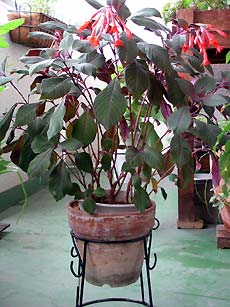
Here is a stem as an example, which has lost leaves on its lower half.
My fuchsia friend in England has once told me that the triphylla hybrids planted in the ground can retain their lower leaves better than those planted in pots, as they can enjoy more free root run.
Unfortunately I don't have ground garden, as I live on an upper floor of a condominium.
My fuchsia friend in England has once told me that the triphylla hybrids planted in the ground can retain their lower leaves better than those planted in pots, as they can enjoy more free root run.
Unfortunately I don't have ground garden, as I live on an upper floor of a condominium.
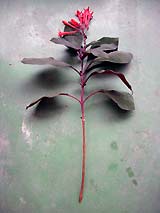
Edit 2009: I have reached a conclusion that high temperature contributes
a lot to this problem and it's almost impossible to maintain lower leaves
in our outdoor climate.
Supplement
High night temperatures can severely exhaust plants.
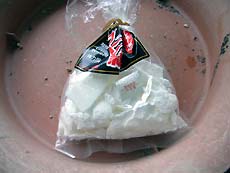
I spray glucose solution (1 g of glucose per 1 liter of water) once or
twice a week to compensate for the energy source spent during the night.
Where I place fuchsias in July
Temperature below 27 oC
While the temperatures are still in a tolerable range (day high: 26 - 27oC, day low: 22oC or lower), fuchsias can be grown outside all day.
While the temperatures are still in a tolerable range (day high: 26 - 27oC, day low: 22oC or lower), fuchsias can be grown outside all day.
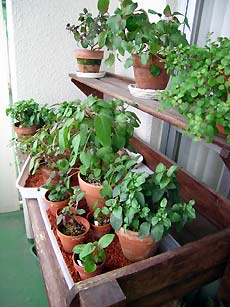
Temperature close to 30oC
After the rainy season, the temperature rises severely. Fuchsias can be placed outdoors only in the morning while the temperature is still below 30oC.
In the afternoon, they have to be brought indoors. Here the temperature is several degrees lower than outside.
In the evening, they can be taken back outdoors again, if the night temperature is still tolerable.
After the rainy season, the temperature rises severely. Fuchsias can be placed outdoors only in the morning while the temperature is still below 30oC.
In the afternoon, they have to be brought indoors. Here the temperature is several degrees lower than outside.
In the evening, they can be taken back outdoors again, if the night temperature is still tolerable.
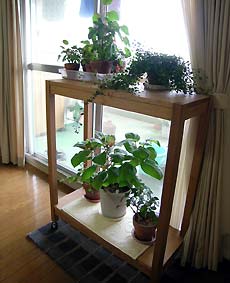
Hot, stuffy night
Toward the end of July, the night temperature begins to stay above 25oC.
Air conditioning is necessary all night for humans to sleep comfortably. This also applies to fuchsias. They spend nights in the air-conditioned dining-living room (temperature: 25 - 26oC).
In March I had a total number of 26 fuchsia plants. Now, the number is reduced to 19, which is necessary to handle individual plants more carefully.
Toward the end of July, the night temperature begins to stay above 25oC.
Air conditioning is necessary all night for humans to sleep comfortably. This also applies to fuchsias. They spend nights in the air-conditioned dining-living room (temperature: 25 - 26oC).
In March I had a total number of 26 fuchsia plants. Now, the number is reduced to 19, which is necessary to handle individual plants more carefully.
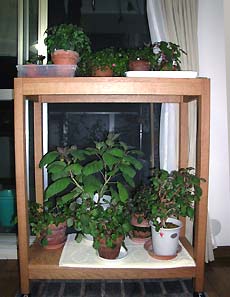
Note that most of my fuchsias are highly heat-tolerant. Only heat-tolerant fuchsias can survive at above temperatures. Less heat-tolerant fuchsias require cooler conditions.
Tip/s I keep in mind is/are to:
- Observe how fast the compost get dried to know whether fuchsias are taking water normally. If the compost dries too slowly, this can mean the fuchsia has closed its stomata because of severe heat and stopped taking water, which can lead to root rot as the compost is saturated with water for a long time. To help the fuchsia to take up water normally, it is advisable to immediately move the fuchsia to a cooler place.
- AmeDAS - Automatic Meteorological Data Acquisition System installed by the Japan Meteorological Agency. A total of 13,000 AmeDASs are installed across Japan (as of January 2007). The measurement data are accessible via the Internet.
Month
- December (2006)
- January (2007)
- February - 1
- February - 2
- March
- April
- May
- June
- July
- August
- September
- October - 1
- October - 2
- November
The fuchsia year shows year-round care of my fuchsias, from Dec. 2006 through to Nov. 2007
as an example.
The original articles were written in Japanese language for fuchsia growers in Japan.
Temperature averages in July 2007:
Daily high:29.1oC
Daily low:22.0oC
(Data by Nearest AmeDAS)
The original articles were written in Japanese language for fuchsia growers in Japan.
Temperature averages in July 2007:
Daily high:29.1oC
Daily low:22.0oC
(Data by Nearest AmeDAS)
HOME (English) > The fuchsia year Top > July
Copyright (C) Just Fuchsias by YoYo. All right reserved